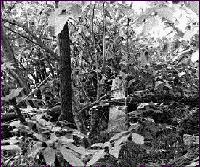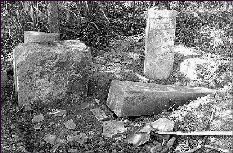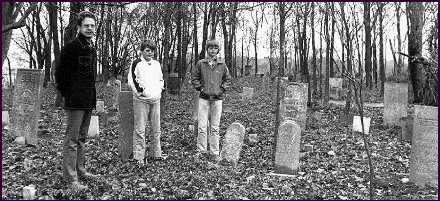While I was helping Tom Homan and others clean up the
Hardin Pioneer (Carey) Cemetery again last year, he asked about the record of the original
work of 1980, and suggested that it be transcribed to digital media. Gene Mozley had
graciously typed my notes back then, when few personal computers were around. Now it would
only take some evening efforts to make the information more available and easy to handle.
Going
back over the journal kept in 1980 brought back memories. That first Carey Cemetery
project was begun after a series of news articles and letters appeared in the Sidney
Daily News in late 1980, telling of the longstanding neglect of this historical site.
I hadn’t known before there even was a cemetery in that familiar woodlot. The chance
presented itself for some hard but enjoyable work in the outdoors. A service could be done
and some interesting things learned, so we went to it — my family and I, our young
friend Doug Richards, and even my father when he came to visit.
Preliminary arrangements made, son Greg and I went on August 13 to lay out our plan and
begin work, but a bad storm came up before we got much done. The next evening, we started
again in the northeast corner, clearing an area and probing with pitchforks and a tile
finder, to get a place where brush could be piled. The site was heavily covered with
grapevines, hawthorns, multiflora, raspberries, poison ivy, and other brush. The first
headstone was unearthed, having been covered with sod and with rubbish that was dumped
over it long ago. It was that of a child who had died in 1853 on August 13, the same day
of the year we had started work! It was also the first of many we were to find that were
not in the records.
The old gate on the north side was rusted beyond hope, along with the posts, so we had
to forget about that, and went on with the task of clearing brush and probing every square
foot. Most markers on the north side were found 2-3 inches under the sod. Their heavy
bases, into which mortises were cut for insertion of the headstones, had to be pried up
and leveled by placing stone underneath.
Theft, Dumping, Vandalism
In one area, many bases were missing, probably having been stolen for building
purposes. Another area was hard to probe because old bricks had been dumped there. Signs
of vandalism were common.
As we moved along, the work got harder, with the roots thick over the stones, some of
which were down nearly a foot deep, one on top of another in a few places. The weather
became very hot and humid at one point. One evening fog settled in and we became so sweaty
we couldn’t hold on to the tools.
More and more previously unlisted markers were located, and it was found that, in
checking old records, some were erroneous or short on information actually there. Many
stones, although recorded earlier, were buried under the sod now, along with those which
had been unknown.
Groundhog Damage
Groundhogs had undermined memorials, their tunnels later caving in, with the stones
falling over and sinking with them. New burrows were dug, the dirt brought up covering
over the sinking stones. The process was repeated over and over in some places, so that
headstones were found as much as three deep and two feet down. The burrows went down so
far that casket handles and hinges had been brought to the surface, as well as a few
pieces of human bone. It seemed paradoxical that the toppled and buried stones were the
best preserved.
With the
headstones and footstones came larger monuments. In this school of practical education,
Greg and Mark began their lessons in physics. Having no heavy equipment, which would have
been destructive anyhow, simple machines — inclined plane, lever, wheel, and pulley
— were put to effective use as we applied spud bar and comealong. After the Stephens
monument base had been put back together and leveled, its obelisk was winched up a heavy
plank on rollers made from pieces of sapling. The plank was then used as a lever to help
get it upright.
Measuring the toppled Burress memorial and figuring in the
specific gravity of marble showed it to be about 917 pounds. Its bottom end was raised up
to the high base with chain, rope, and comealong, the base protected with wood and used as
a fulcrum. A pulley was fastened to a stout tree branch overhead to lift it upright. Poles
were used to steady and guide it from a safe distance; a slip could have been disastrous.
We spent almost 3 hours getting the deeply buried McClintock obelisk up out of the ground
and upright on its base, using a jack, levers, ropes, and the comealong.

The George
Savage marker in the background, center, was one of the few standing before restoration
work at
Carey Cemetery began just 20 years ago by the Diehl family and others.

The
McClintock monument, at right, was unearthed after being buried under the tombstone behind
it,
with yet another stone over that. Workers reset the base for the McClintock stone.
Metal Detector Used
After the big Wilson coverstones were leveled and the last of the burials had been located
and fixed up as well as possible, we went over the whole place with a metal detector,
finding nothing of antiquity other than an assortment of hinges and escutcheons from
coffins and a place where someone had spilled some wrought nails.
Finally, after 69 days
and 250 hours of labor, the 1/2 acre cemetery had been cleaned and restored as much as
possible, without cash expense. One-hundred-sixteen previously recorded burials were
identified. One-hundred-one unrecorded burials were found. Of the latter, a few had very
little or no useful information because of effacement, missing parts, or lack of any
inscription. Also, a few of this number represented corrections to previous data. There
are surely more burials, because of obvious grave-shaped depressions in east to west
arrangement with no markers, and repeated reports that headstones have been seen around
the Hardin area. In fact, a few were returned one day.
Revolutionary War Soldiers Buried at
Carey
Of the four Revolutionary War veterans said
to be buried there only one grave, that of Rev. Wm. F.R. Davis, was located. One
Revolutionary Veteran’s flagstand was found. Rumors were heard of James Cannon’s headstone
being in a sidewalk somewhere.
Reading through Turtle Creek and Washington Townships’ historical records with
Carey Cemetery’s inscriptions in hand brings to mind how rightfully it is called a
"pioneer cemetery." Many of
those interred came from Virginia, Pennsylvania, and other places to the east to be the
first settlers on their land. The graves of their young wives and small children bear
witness to the hardships of those times. By far the most burials by age were of infants of
less than one year. Mortality declined with age after that until puberty, after which a
person appeared as likely to die at any one given age as another through the eighth
decade. In present times, we would expect mortality to increase with old age.
The "life" of the cemetery spanned 82 years, with most known burials being in
the period 1835 to 1875. The most occurring in one year was 15, in 1850, about double the
usual number.
The earliest known interment was that of Jane, wife of Cephas Carey, who was
one of the first settlers. She died in 1814, only two years after they arrived. We
uncovered the tombstone of Mary Brodrick Cannon. She and her husband Richard were the
first to be married in Turtle Creek, in 1818, by Cephas Carey, who was then justice of the
peace. Her son, N.F., lies near her. He died in the army at Murfreesboro.
We found the grave of Abraham Davenport, who had been born in Virginia and grew up in
Ross County before bringing his wife Penelope to Washington Township in 1817. A headstone
for William McClintock, who came from Kentucky in 1824, had been recorded before it was
covered over by groundhogs. What had not been known was that deep under it was the big
family marker for him, his wife Sarah, and five of their children.
From
left, author Lew Diehl, Doug Richards, and Greg Diehl survey their finished work at Carey
Cemetery, October 25, 1980.

Also newly discovered were the graves of Basil (Bazzel according to the stone) Burton
and his wife. He had settled near Hardin in 1817, as did David Coon. Ebenezer Stephens
arrived the previous year. Joshua Cole and Thomas Shaw came somewhat later.
William Davis was from Maysville. He began cutting for the Hardin-Wapakoneta Road about
1820. He also built the first brick house in Turtle Creek. John and Anna Wilson had built the
first one in the county in Washington Township in 1816.
Richard Lenox was one of the earliest school teachers. Joseph Jackson built the first
wagon shop later on in 1840. We unearthed the monument of little Elizabeth Campbell, who
had drowned in Turtle Creek.
George Savage, born in Virginia in the year of the Revolution, traveled all over with
the army before finally settling in Washington Township about 1825. He kept a public house
on the canal for some time, and finally moved to Turtle Creek.
Causes of Cemetery Damage
Neglect, which appeared to have been a problem for 100 years, had obviously
been total for many years. This could be seen by the size of the underbrush, and
grapevines so big a chainsaw was needed to cut them. Only one headstone showed evidence of
being damaged and repaired, and this was buried. A few had been replaced a hundred or more
years ago; earlier stones with the same inscriptions were found. A few, including that of
the Rev. Davis, obviously lay face up for decades before being covered over with sod, while
pieces of the same kind of stones buried face down were in like-new condition. The former
were quite eroded in comparison.
Vandalism
Some old, some said to have occurred about 1970, was the worst problem, coupled with
theft. Some stones were so displaced that burial location will never be known. Many, some
of them works of art, were irreparably broken, with some pieces impossible to find and
information permanently lost. Finally, groundhogs had completely undermined some areas for
many years and caused monuments to topple and eventually sink beneath the surface.
__________________________________
The author performed this work in 1980 with hopes that
several things would result from the volunteer work to restore Carey Cemetery:
- Township trustees and others would care for
this cemetery as any other in the future. Public opinion would help assure that this would
happen.
- Some might come to learn more about their
ancestors and the history of the area.
- There would be no chance of anyone ever
getting clearance to bulldoze and farm over this ground as has been done elsewhere.
Publicity and public opinion would cause shame for what had been done here and prevent
some further occasions of desecration.
- More people might come to believe that pride
in their heritage and in the earth are good things, as is the hard work to preserve them.
PERMELIA COLBY
Not long after the Carey Cemetery restorations, a neighbor
called to say that he had been taking up a stone walk to an old outhouse and, in turning
one slab up, found that it was a tombstone. The inscription was:
PERMELIA
Wife of Joseph Colby - Died May 21, 1863 - Aged 72 Y 2 M 29 D
Sutton’s History of Shelby County reveals that
this lady was one of the earlier settlers of southwestern part of the county. Joseph
S. Colby, son of Joseph and Permelia Colby of Butler County, brought his father’s
family to Washington Township in the autumn of 1837 and located near Lockington. He
married Abigail Johnston of the local area in 1838. In 1845, they purchased and moved to a
farm in section 27 of Loramie Township.
Permelia’s descendants are buried in
the Johnston Cemetery near Piqua, but her husband’s burial place remains unknown as
does her own. No Colby markers could be found in the old section of Lockington Cemetery.
We were unable to find anyone interested in her tombstone, and it yet remains without a
proper place to be. —Lew Diehl
[ Back to People Index ] |

